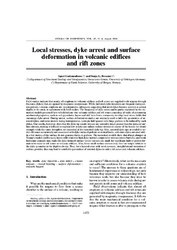Local stresses, dyke arrest and surface deformation in volcanic edifices and rift zones
Gudmundsson, Agust
Brenner, Sonja L.
47, 4: 1433 - 1454
DOI: https://doi.org/10.4401/ag-3352
Persistent URL: http://resolver.sub.uni-goettingen.de/purl?gldocs-11858/6750
Persistent URL: http://resolver.sub.uni-goettingen.de/purl?gldocs-11858/6750
Gudmundsson, Agust; Brenner, Sonja L., 2004: Local stresses, dyke arrest and surface deformation in volcanic edifices and rift zones. In: Gudmundsson, Agust; Brenner, Sonja L. (2004): Local stresses, dyke arrest, and surface deformation in volcanic edifices and rift zones, DOI: 10.4401/ag-3352.
 |
Dokument öffnen: |
Field studies indicate that nearly all eruptions in volcanic edifices and rift zones are supplied with magma through
fractures (dykes) that are opened by magmatic overpressure. While (inferred) dyke injections are frequent during unrest
periods, volcanic eruptions are, in comparison, infrequent, suggesting that most dykes become arrested at certain
depths in the crust, in agreement with field studies. The frequency of dyke arrest can be partly explained by the numerical
models presented here which indicate that volcanic edifices and rift zones consisting of rocks of contrasting
mechanical properties, such as soft pyroclastic layers and stiff lava flows, commonly develop local stress fields that
encourage dyke arrest. During unrest, surface deformation studies are routinely used to infer the geometries of arrested
dykes, and some models (using homogeneous, isotropic half-spaces) infer large grabens to be induced by such
dykes. Our results, however, show that the dyke-tip tensile stresses are normally much greater than the induced surface
stresses, making it difficult to explain how a dyke can induce surface stresses in excess of the tensile (or shear)
strength while the same strength is not exceeded at the (arrested) dyke tip. Also, arrested dyke tips in eroded or active
rift zones are normally not associated with dyke-induced grabens or normal faults, and some dykes arrested within
a few metres of the surface do not generate faults or grabens. The numerical models show that abrupt changes in
Young’s moduli (stiffnesses), layers with relatively high dyke-normal compressive stresses (stress barriers), and weak
horizontal contacts may make the dyke-induced surface tensile stresses too small for significant fault or graben formation
to occur in rift zones or volcanic edifices. Also, these small surface stresses may have no simple relation to
the dyke geometry or the depth to its tip. Thus, for a layered crust with weak contacts, straightforward inversion of
surface geodetic data may lead to unreliable geometries of arrested dykes in active rift zones and volcanic edifices.
Statistik:
ZugriffsstatistikSammlung:
- Geologie [931]

